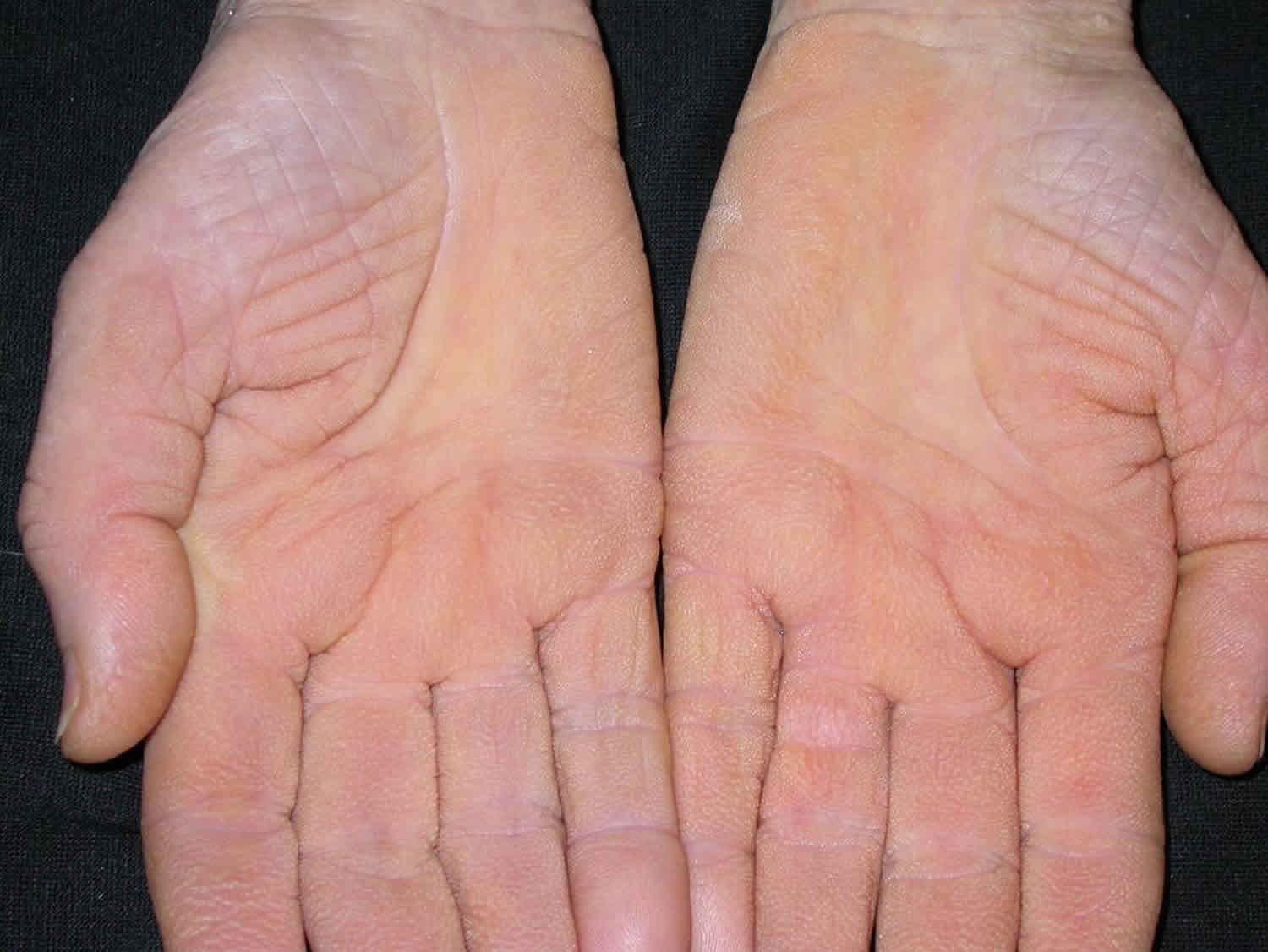Tripe palms
Tripe palms also known as acanthosis palmaris or acquired pachydermatoglyphia, is an unusual cutaneous paraneoplastic syndrome characterized by thickened velvety palms with an accentuation of the normal dermatoglyphic ridges and sulci that have the appearance of tripe, the stomach lining of beef, pork, or sheep 1. Tripe palms alone or in combination with acanthosis nigricans is strongly associated with internal malignancy, especially carcinomas of the gastrointestinal tract and lung. Tripe palms skin disease is very rare. Tripe palms usually occurs before the diagnosis of the cancer, but may arise during any point in the course of the malignancy. Any patient with tripe palms must have a complete cancer workup, as in many of the cases it often precedes the malignancy by many months.
Figure 1. Tripe palms

Footnote: (A) Both palms have a characteristic ridged papillomatous appearance and coarse texture. (B) In the close-up image, accentuation of dermatoglyphics resembling tripe is seen. [Source 2 ]
Figure 2. Acanthosis nigricans
Tripe palms causes
The cause of tripe palms is not clearly understood but is thought that it is due to substances from the associated cancer that stimulate the palmar skin cells to proliferate 1. Elevated serum epidermal growth factor was described in a patient of tripe palms and carcinoma of bronchus 3. In most of the cases (90%) tripe palms is associated with underlying internal malignancy either alone or in combination with acanthosis nigricans. Evidence from published literatures has shown that in 77% of cases tripe palms is associated with acanthosis nigricans, whereas in 23% of cases it occurs alone 4. The most common associated neoplasms are pulmonary and gastric carcinoma followed by esophagus, rectum, bronchus, urinary tract, ovary, bile duct, thyroid, uterus, liver, kidneys, and breast 5.
The most common malignancy in the patients with both tripe palms and acanthosis nigricans is stomach (35%) followed by lungs (11%), whereas patients with tripe palms alone frequently had lung carcinoma (53% of cases) 4. The onset of tripe palms precedes malignancy in more than 40%, follows malignancy in 19%, or can be concurrent within 1 month of the diagnosis of malignancy in 37% of patients 6.
In cases where tripe palms occur without acanthosis nigricans, lung cancers are usually responsible. Less commonly associated cancers include head and neck tumors, and tumors of the genitourinary tract.
Tripe palms are less frequently associated with bullous pemphigoid, psoriasis, and exfoliative dermatitis.
Tripe palms diagnosis
The diagnosis is made from the characteristic appearance of tripe palms. Scaling and skin thickening may be noted on skin biopsy but these are are non-specific histological findings.
In over 40% of patients, tripe palms are the first sign of an undiagnosed cancer, hence all patients should undergo a full diagnostic workup for an associated malignancy, particularly lung or gastrointestinal carcinoma.
Tripe palms treatment
Patients with tripe palms need to undergo medical examination, appropriate blood tests and X-rays to check for internal malignancies.
There is no specific treatment for tripe palms. It has been reported that approximately 30% of cases resolve once the underlying cancer is treated. However, tripe palms inconsistently respond to successful therapy and may persist for many years despite remission of the underlying cancer.
Although the efficacy results are usually unsatisfactory, there have been some reports on improvement of skin lesions after surgical or chemotherapeutical treatment of malignancy 7. The relapse of cutaneous symptoms may indicate the progression or recurrence of the primary tumor 8. Dermatological treatment of skin lesions in malignant acanthosis nigricans includes orally administered retinoids, cyproheptadine and PUVA therapy (psoralen and UVA therapy). Only a few observations have confirmed the clinical improvement after treatment with topical calcipotriol, topical 5-fluorouracil or systemic retinoids 9.
References- Barman B, Devi LP, Thakur BK, Raphael V. Tripe Palms and Acanthosis Nigricans: A Clue for Diagnosis of Advanced Pancreatic Adenocarcinoma. Indian Dermatol Online J. 2019;10(4):453–455. doi:10.4103/idoj.IDOJ_427_18 https://www.ncbi.nlm.nih.gov/pmc/articles/PMC6615400
- Chong, Wei-Sheng. (2015). Oral Malignant Acanthosis Nigricans and Tripe Palms Associated With Renal Urothelial Carcinoma. JAMA Dermatology.
- Douglas F, McHenry PM, Dagg JH, MacBeth FM, Morley WN. Elevated levels of epidermal growth factor in a patient with tripe palms. Br J Dermatol. 1994;130:686–7.
- Cohen PR, Grossman ME, Almeida L, Kurzrock R. Tripe palms and malignancy. J Clin Oncol. 1989;7:669–78.
- Pentenero M, Carrozzo M, Pagano M, Gandolfo S. Oral acanthosisnigricans, tripe palms and sign of leser-trélat in a patient with gastric adenocarcinoma. Int J Dermatol. 2004;43:530–2.
- Abreu Velez AM, Howard MS. Diagnosis and treatment of cutaneous paraneoplastic disorder. Dermatol Ther. 2010;23:662–75.
- Anderson SHC, Hudson-Pfacock M, Muller AF. Malignant acanthosis nigricans: potential role of chemotherapy. Br J Dermatol. 1999;141:714–6.
- Longhsore S, Taylor J, Kennedy A, et al. Malignant acanthosis nigricans and endometrioid adenocarcinoma of the parametrium: the search for malignancy. Am Acad Dermatol. 2003;49:541–3.
- Swineford SL, Drucker CR. Palliative treatment of paraneoplastic acanthosis nigricans and oral florid papillomatosis with retinoids. J Drugs Dermatol. 2010;9:1151–3.






